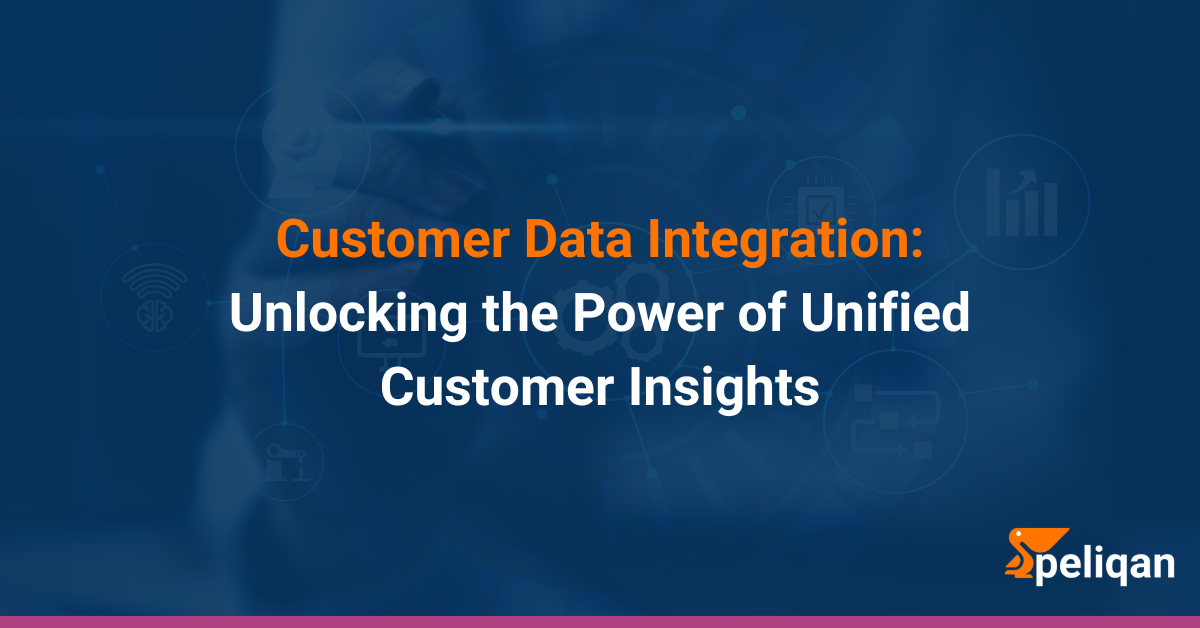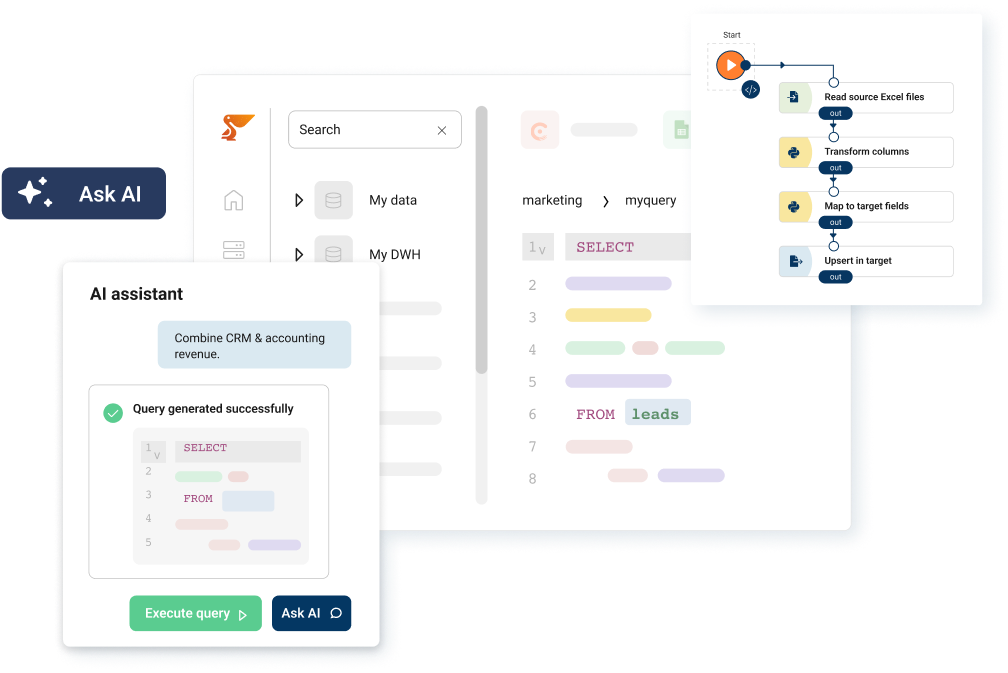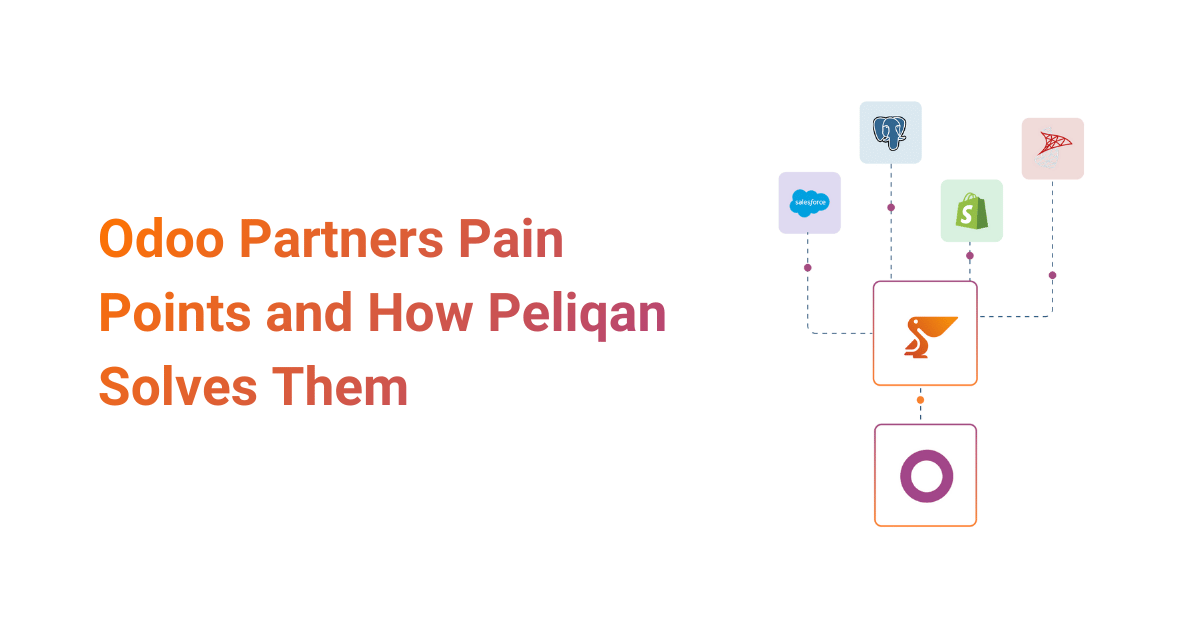In today’s data-driven business landscape, understanding your customers is more crucial than ever. With the explosion of digital touchpoints and the increasing complexity of customer journeys, businesses are inundated with vast amounts of customer data.
However, this data is often scattered across various platforms, departments, and systems, making it challenging to gain a holistic view of customers. This is where customer data integration (CDI) comes into play. Let’s dive deep into the world of CDI and explore how it can transform your business operations and drive growth.
What is Customer Data Integration?
Customer data integration is the process of collecting, consolidating, and managing customer data from multiple sources into a single, unified view. It involves breaking down data silos and creating a centralized repository of customer information, enabling businesses to gain a 360-degree view of their customers. This comprehensive view leads to more informed decision-making, enhanced customer experiences, and improved operational efficiency across the organization.
CDI goes beyond simple data aggregation. It involves complex processes of data cleansing, normalization, and standardization to ensure that the integrated data is accurate, consistent, and usable across different business functions. By creating a “golden record” for each customer, CDI provides a single source of truth that can be relied upon by all departments within an organization.
Types of Customer Data
Before diving deeper, let’s explore the different types of customer data that feed into the CDI process:
Identity Data: The Who
This is the foundational information that identifies a customer as a unique individual. It includes:
- Basic personal details: Name, address, phone number, email address
- Demographic information: Age, gender, occupation, income level
- Account information: Customer ID, account numbers, subscription details
Identity data is crucial for personalizing communications and ensuring accurate record-keeping. It’s often collected through account creation processes, transaction forms, or customer surveys.
Engagement Data: The What and When
Engagement data provides insights into how customers interact with your business across various touchpoints. This includes:
- Website behavior: Pages visited, time spent on site, click-through rates
- Email interactions: Open rates, click rates, unsubscribe rates
- Purchase history: Products bought, frequency of purchases, average order value
- Customer service interactions: Support tickets, call logs, chat transcripts
This type of data is invaluable for understanding customer preferences, predicting future behavior, and tailoring marketing efforts. It’s typically collected through web analytics tools, CRM systems, and customer service platforms.
Attitudinal Data: The Why
Attitudinal data offers insights into customer opinions, preferences, and satisfaction levels. This encompasses:
- Survey responses: Customer satisfaction scores, Net Promoter Score (NPS)
- Product reviews and ratings
- Social media sentiment
- Feedback from focus groups or interviews
This data helps businesses understand how customers perceive their brand, products, and services. It’s often collected through dedicated survey tools, social media monitoring platforms, and review aggregation systems.
Behavioral Data: The How
Behavioral data goes beyond simple engagement metrics to provide a deeper understanding of customer actions and habits. This includes:
- Purchase patterns: Seasonal buying habits, product category preferences
- Channel preferences: Preferred communication channels, shopping platforms
- Feature usage: Most-used product features, abandoned features
- Lifestyle indicators: Hobbies, interests, brand affinities
This data is crucial for segmentation, personalization, and predictive modeling. It’s often derived from a combination of transactional data, web analytics, and third-party data sources.
Key Components of Customer Data Integration
Effective Customer Data Integration (CDI) hinges on several core capabilities that ensure data flows smoothly from source systems into a unified customer 360° view:
- Data Ingestion: Batch and real‑time pipelines (API, change‑data‑capture, event streams) enabling continuous collection from CRM, e‑commerce, support systems, and more.
- Data Transformation: Mapping, enrichment, and normalization to standardize fields (for example, names and addresses) and enhance profiles with third‑party data.
- Data Quality & Governance: Cleansing, deduplication, and lineage tracking to ensure accuracy, auditability, and compliance with regulations like GDPR and CCPA.
- Master Data Management (MDM): Golden‑record creation consolidates multiple records into a single source of truth for each customer.
- Real‑Time Integration & Reverse ETL: Surfaces insights back into CRM or marketing tools for personalization and orchestration in milliseconds.
Customer Data Integration vs. Customer Data Platforms
While often used interchangeably, CDI and CDPs serve distinct purposes:
| Aspect | CDI | CDP |
|---|---|---|
| Primary Focus | Data pipelines and unification | Customer profile storage and activation |
| Core Function | Connect, transform, cleanse | Segmentation, personalization, campaign orchestration |
| Typical Users | Data engineers, IT operations | Marketers, growth teams |
The Importance of Customer Data Integration
Now that we understand what CDI is, let’s explore why it’s crucial for modern businesses:
Enhanced Customer Insights
CDI provides a holistic view of each customer, allowing businesses to understand their needs, preferences, and behaviors better. This deeper understanding enables:
- More accurate customer segmentation
- Improved customer profiling and persona development
- Better prediction of customer lifetime value
- Identification of cross-selling and upselling opportunities
With these enhanced insights, businesses can tailor their products, services, and marketing efforts to meet customer needs more effectively, leading to increased customer satisfaction and loyalty.
Streamlined Operations
By eliminating data silos, CDI reduces redundancies and inconsistencies in customer information. This streamlining of data management leads to:
- Reduced data storage costs by eliminating duplicate records
- Improved data accuracy and reliability across all systems
- Faster and more efficient data retrieval for all departments
- Enhanced compliance with data protection regulations
These operational improvements can lead to significant cost savings and increased efficiency across the organization.
Increased Revenue Opportunities
By leveraging integrated customer data, businesses can uncover new revenue opportunities:
- Identifying high-value customers for targeted marketing efforts
- Personalizing product recommendations based on comprehensive customer profiles
- Developing new products or services based on identified customer needs
- Improving customer retention through proactive engagement strategies
These revenue-enhancing opportunities can significantly impact a company’s bottom line and drive sustainable growth.
Benefits of Customer Data Integration: A Win-Win for Businesses and Customers
| Beneficiary | Benefit | Impact/Outcome |
|---|---|---|
| For Businesses | Enhanced customer insights | Better understanding of customer needs and behaviors, leading to more effective strategies |
| Improved decision-making | Data-driven decisions across departments, resulting in more successful initiatives | |
| Streamlined operations | Increased efficiency and reduced operational costs due to unified data systems | |
| Increased revenue opportunities | Identification of upselling and cross-selling opportunities, boosting overall sales | |
| Better regulatory compliance | Reduced risk of penalties and improved trust with customers and regulators | |
| For Customers | Personalized experiences | Higher satisfaction and loyalty due to tailored interactions and offerings |
| Consistent interactions across channels | Seamless customer journey, regardless of the touchpoint used | |
| Faster problem resolution | Improved customer support with access to comprehensive customer history | |
| Relevant product recommendations | Enhanced shopping experience and increased likelihood of finding desired products | |
| Improved overall satisfaction | Stronger brand loyalty and increased likelihood of repeat business and referrals |
Customer Data Integration: Challenges & Solutions
While the benefits of CDI are clear, the path to implementation isn’t always smooth. Here are some common hurdles businesses face:
Data Quality Issues
Challenge: Inconsistent, duplicate, or outdated data
Data quality problems can arise from various sources, including manual entry errors, system migrations, or outdated information. These issues can lead to incorrect insights, poor decision-making, and decreased customer satisfaction.
Solution: Implement robust data cleansing and validation processes
This involves using data profiling tools to identify anomalies, implementing standardization rules for data entry, and employing machine learning algorithms for duplicate detection. Regular data quality audits and automated cleansing processes can help maintain data integrity over time.
Technical Complexity
Challenge: Integrating diverse systems and data formats
Organizations often have multiple systems storing customer data, each with its own data structure and format. Legacy systems may use outdated technologies that are difficult to integrate with modern platforms. This complexity can lead to data silos and hinder the creation of a unified customer view.
Solution: Choose flexible CDI tools and consider phased implementation
Opt for CDI solutions that offer a wide range of pre-built connectors and support custom integrations. Implement the integration in phases, starting with the most critical data sources. This approach allows for easier management of the integration process and provides opportunities to learn and adjust as you progress.
Data Privacy and Security
Challenge: Ensuring compliance with regulations like GDPR and CCPA
As data privacy regulations become more stringent, businesses must ensure that their CDI practices comply with laws like GDPR and CCPA. This includes managing customer consent, protecting sensitive data, and providing customers with control over their personal information.
Solution: Implement strong data governance and security measures
Develop a comprehensive data governance framework that outlines policies for data collection, usage, and storage. Implement robust security measures such as encryption, access controls, and regular security audits. Provide training to employees on data privacy best practices and establish processes for handling data subject requests.
Ongoing Maintenance
Challenge: Keeping integrated data accurate and up-to-date
Customer data is constantly changing as people move, change jobs, or update their preferences. Without proper maintenance, the value of integrated data can quickly deteriorate, leading to poor decision-making and suboptimal customer experiences.
Solution: Establish regular data audits and update processes
Implement automated processes to regularly check for and update changed information across all integrated systems. Set up alerts for significant data discrepancies or anomalies. Establish a data stewardship program where designated individuals are responsible for maintaining data quality in their respective areas.
Best Practices for Implementing CDI
To overcome these challenges and reap the full benefits of CDI, consider the following best practices:
- Define Clear Objectives: Start with business use cases (for example, churn prediction or cross‑sell offers) to scope your data flows.
- Adopt a Metadata‑Driven Approach: Store schemas, field mappings, and transformation rules centrally to simplify maintenance.
- Implement Robust Error‑Handling: Design retry logic, alerting, and dead‑letter queues to surface and resolve integration failures quickly.
- Leverage Streaming for Real‑Time Needs: Use tools like Kafka, Kinesis, or Pulsar to enable sub‑second updates—critical for live personalization.
- Enforce Data Governance: Classify sensitive data, encrypt both at rest and in transit, and maintain audit logs to satisfy compliance requirements.
- Monitor & Optimize: Track latency, throughput, and data quality KPIs; routinely iterate on pipelines that are slow or error‑prone.
Tools for Customer Data Integration
Several types of tools can help streamline your CDI efforts:
Customer Data Platforms (CDPs)
CDPs are purpose-built for customer data integration, offering robust features for collecting, unifying, and analyzing customer data. Key capabilities include:
- Data ingestion from multiple sources
- Identity resolution and customer profile unification
- Segmentation and audience management
- Real-time data activation
Data Integration Platforms
These tools offer a wide range of connectors and can handle both batch and real-time data integration. They typically provide:
- Pre-built connectors for various data sources
- Data transformation and mapping capabilities
- Workflow automation features
- Monitoring and error handling
Customer Relationship Management (CRM) Systems
Many modern CRMs offer built-in data integration capabilities, making them a good starting point for CDI efforts. CRM features often include:
- Contact and lead management
- Integration with marketing automation tools
- Customer interaction tracking
- Basic analytics and reporting
Data Virtualization Tools
These create a virtual layer for accessing data from multiple sources without physically moving it, offering flexibility and real-time access. Key features include:
- Real-time data access across multiple sources
- Reduced data replication and storage costs
- Simplified data governance
- Improved data agility
Types of CDI tools
Here’s a comparison table of these different types of CDI tools:
| Tool Type | Strengths | Best For | Examples |
|---|---|---|---|
| Customer Data Platforms (CDPs) | Unified customer view, real-time activation | Companies focused on personalization and omnichannel experiences | Segment, Tealium |
| Data Integration Platforms | Wide range of connectors, robust transformation capabilities | Organizations with diverse data sources and complex integration needs | Talend, Informatica |
| CRM Systems | Built-in customer data management, user-friendly interfaces | Small to medium businesses looking for an all-in-one solution | Salesforce, HubSpot |
| Data Virtualization Tools | Real-time data access, reduced data duplication | Large enterprises with complex data landscapes | Denodo, TIBCO |
Pro Tip: When selecting a CDI tool, consider solutions that offer a comprehensive, all-in-one approach to data management. One such platform that deserves attention is Peliqan.
Peliqan.io stands out as a versatile, all-in-one data platform designed for business teams, startups, scale-ups, and IT service companies. It offers a unique combination of features that address many of the challenges associated with customer data integration:
- Comprehensive Connectivity: Peliqan allows you to connect to over 250 SaaS applications, databases, and file sources, making it easy to consolidate data from various customer touchpoints.
- Built-in or Bring Your Own Data Warehouse: The platform offers a built-in data warehouse, or you can integrate with popular options like Snowflake, BigQuery, Redshift, or SQL Server.
- Flexible Data Transformation: Peliqan supports SQL, low-code Python, and even AI-assisted query writing, catering to users with different levels of technical expertise.
- Data Activation Capabilities: Beyond just integrating data, Peliqan offers features for reverse ETL, API publishing, alerting, and distribution of personalized reports, enabling you to act on your integrated customer data effectively.
- AI-Powered Assistance: Peliqan’s AI assistant can help write SQL queries, accelerating the process of gaining insights from your integrated customer data.
By offering this comprehensive suite of features, Peliqan addresses many of the challenges associated with customer data integration, from data collection and storage to analysis and activation. Its all-in-one approach can significantly simplify the CDI process, making it an attractive option for businesses looking to implement or improve their customer data integration strategy.
Conclusion
As we’ve explored throughout this article, customer data integration is a complex but crucial process for businesses seeking to leverage their data for improved customer experiences and business outcomes. While there are challenges to overcome, the right strategy and tools can make the process much more manageable.
Platforms like Peliqan represent the next evolution in customer data integration tools. By offering an all-in-one solution that covers everything from data collection and storage to analysis and activation, these platforms are making it easier than ever for businesses of all sizes to implement effective CDI strategies.
Whether you’re a small startup or a large enterprise, tools like Peliqan can help you unlock the full potential of your customer data, driving better decision-making, more personalized customer experiences, and ultimately, business growth.
As you embark on or continue your customer data integration journey, remember that the goal is not just to collect and store data, but to make it actionable. Look for solutions that not only integrate your data but also provide the tools to analyze it effectively and act on those insights. With the right approach and tools, you can turn your customer data into a powerful asset that drives your business forward in today’s data-driven economy.





